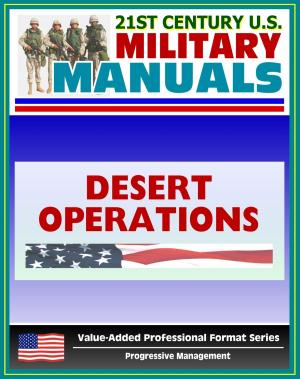Combat Operations C3I: Fundamentals and Interactions - Command, Control, Communications, and Intelligence
Nonfiction, Science & Nature, Technology, Aeronautics & Astronautics, History, Military, Aviation| Author: | Progressive Management | ISBN: | 9781476189482 |
| Publisher: | Progressive Management | Publication: | June 23, 2012 |
| Imprint: | Smashwords Edition | Language: | English |
| Author: | Progressive Management |
| ISBN: | 9781476189482 |
| Publisher: | Progressive Management |
| Publication: | June 23, 2012 |
| Imprint: | Smashwords Edition |
| Language: | English |
The author introduces basic definitions, functions, and processes of command, control, communications, and intelligence (C3I). He develops a conceptual model of the combat operations process based on the American approach to war. The study investigates the stochastic nature of combat operations and develops a guide to effective command. Major Orr concludes that a distributed C3I architecture designed to exploit the unpredictability of combat is best suited to the true nature of combat and the strengths of American fighting units.
Chapter I summarizes the work of the military theorists I found most useful and discusses the American approach to war. Challenges to this approach by advocates of "maneuver warfare" also receive attention. These summaries form the basis for later comments on the nature of war and the combat operations command process. Chapter II introduces the basic definitions, functions, and process of C3I. I then modify a conceptual model of the C3I process to produce a conceptual model of the combat operations process. The detailed discussion of the decision and force application functions within this process introduces two additional conceptual models. The power distribution model describes combat in terms of the location of sources of power and the ability of these power sources to apply military force. This model includes the evolution of this power distribution due to maneuver and actual combat interactions. This power distribution model is the basis for the discussion of command in Chapter III. The second model is introduced in the military problem-solving process model. This model, applied to the problem of controlling the evolution of the power distribution, provides the framework for the investigation of effective command of the combat operations process. Chapter III looks at the concept of command in combat operations. It identifies and discusses the implications of the stochastic nature of combat operations—the unpredictability of combat results and the uncertain, probabilistic nature of combat. Theoretical concepts are illustrated using simple military examples. As a result of these observations, the chapter defines military command as control of the evolution of the power distribution, and it links strategy to the problem of influencing this evolution into desirable patterns.
Contents * Foreword * PREFACE * Chapter 1 * COMBAT OPERATIONS * Sun Tzu * Objectives of War * Civil-Military Relationships * Principles of War * Tactical Principles * Carl von Clausewitz * Andre Beaufre * The American Style of War * The Traditional Approach * Maneuver Warfare * Notes * Chapter 2 * C3I AND THE COMBAT OPERATIONS PROCESS * Command, Control, Communications, and Intelligence (C3I) * The Combat Operations Process Model * Expansion of the Process Model Functions * Notes * Chapter 3 * COMMAND OF THE COMBATION OPERATIONS PROCESS * The Purpose of Command * Use of the Power Distribution * Implication of this Interpretation of Command * Notes * Chapter 4 * EFFECTIVE COMMAND OF COMBAT OPERATIONS * The Military Problem-Solving Process * Determination of the Desired Power Distribution * Determination of the Current Situation * Determination and Evaluation of Possible Actions * Selection of a Plan * Execution of the Plan * The ACT Function * Communications Links and Interfaces * Military Theory in the Problem-Solving * Formulation * Notes * Chapter 5 * C3I IN COMBAT OPERATIONS * C3I in the Combat Operations Process * C3I in the Military Problem-Solving Process * C3I and the Nature of Combat Operations * C3I and the Desired Style of Military Command * Summary * Notes * GLOSSARY
The author introduces basic definitions, functions, and processes of command, control, communications, and intelligence (C3I). He develops a conceptual model of the combat operations process based on the American approach to war. The study investigates the stochastic nature of combat operations and develops a guide to effective command. Major Orr concludes that a distributed C3I architecture designed to exploit the unpredictability of combat is best suited to the true nature of combat and the strengths of American fighting units.
Chapter I summarizes the work of the military theorists I found most useful and discusses the American approach to war. Challenges to this approach by advocates of "maneuver warfare" also receive attention. These summaries form the basis for later comments on the nature of war and the combat operations command process. Chapter II introduces the basic definitions, functions, and process of C3I. I then modify a conceptual model of the C3I process to produce a conceptual model of the combat operations process. The detailed discussion of the decision and force application functions within this process introduces two additional conceptual models. The power distribution model describes combat in terms of the location of sources of power and the ability of these power sources to apply military force. This model includes the evolution of this power distribution due to maneuver and actual combat interactions. This power distribution model is the basis for the discussion of command in Chapter III. The second model is introduced in the military problem-solving process model. This model, applied to the problem of controlling the evolution of the power distribution, provides the framework for the investigation of effective command of the combat operations process. Chapter III looks at the concept of command in combat operations. It identifies and discusses the implications of the stochastic nature of combat operations—the unpredictability of combat results and the uncertain, probabilistic nature of combat. Theoretical concepts are illustrated using simple military examples. As a result of these observations, the chapter defines military command as control of the evolution of the power distribution, and it links strategy to the problem of influencing this evolution into desirable patterns.
Contents * Foreword * PREFACE * Chapter 1 * COMBAT OPERATIONS * Sun Tzu * Objectives of War * Civil-Military Relationships * Principles of War * Tactical Principles * Carl von Clausewitz * Andre Beaufre * The American Style of War * The Traditional Approach * Maneuver Warfare * Notes * Chapter 2 * C3I AND THE COMBAT OPERATIONS PROCESS * Command, Control, Communications, and Intelligence (C3I) * The Combat Operations Process Model * Expansion of the Process Model Functions * Notes * Chapter 3 * COMMAND OF THE COMBATION OPERATIONS PROCESS * The Purpose of Command * Use of the Power Distribution * Implication of this Interpretation of Command * Notes * Chapter 4 * EFFECTIVE COMMAND OF COMBAT OPERATIONS * The Military Problem-Solving Process * Determination of the Desired Power Distribution * Determination of the Current Situation * Determination and Evaluation of Possible Actions * Selection of a Plan * Execution of the Plan * The ACT Function * Communications Links and Interfaces * Military Theory in the Problem-Solving * Formulation * Notes * Chapter 5 * C3I IN COMBAT OPERATIONS * C3I in the Combat Operations Process * C3I in the Military Problem-Solving Process * C3I and the Nature of Combat Operations * C3I and the Desired Style of Military Command * Summary * Notes * GLOSSARY















